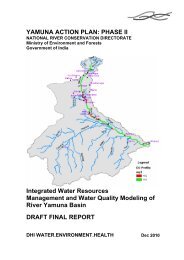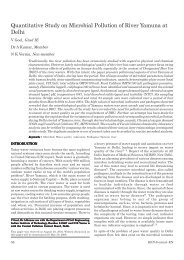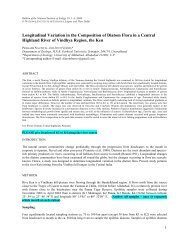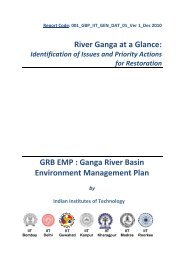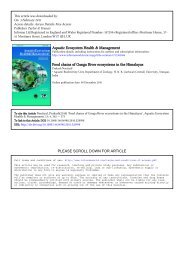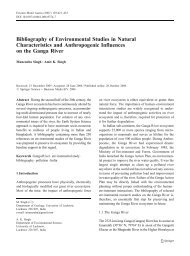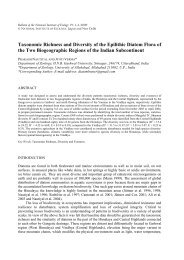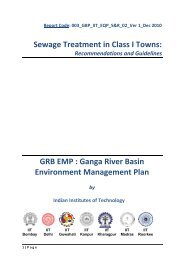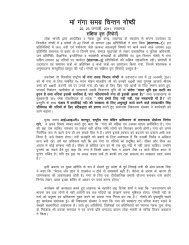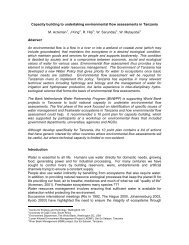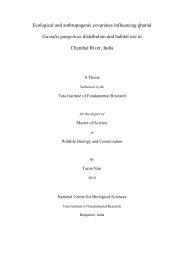GENERAL ARTICLES 762 Sewage from City De-Silting & De-Gritting Advanced Facult<strong>at</strong>ive Pond High R<strong>at</strong>e Pond RL-73 m RL-72.6 m Pond 1 Pond 2 Ferment<strong>at</strong>ion Pits Pump Re-circul<strong>at</strong>ion <strong>to</strong> maintain aerobic cap in Pond 1 RL-72.3 m RL-71.7 m Pond 3 Pond 4 Algae Settling Ponds M<strong>at</strong>ur<strong>at</strong>ion Pond For Irrig<strong>at</strong>ion POND CUMULATIVE POLLUTION REMOVAL POND-1 BOD- 80 % FCC- 1 Log TOTAL METHANE FERMENTATION OF ORGANIC MATTER LEAVING NO SLUDGE POND-2 BOD- 85 % FCC- 2 Log NUTRIENTS & INORGANIC MATTER IS ASSIMILATED BY MICRO ALGAE POND-3 BOD- 90 % FCC- 3 Log POND-4 BOD- 95TO 99 % FCC- 4 TO 5 Log Figure 4. Schem<strong>at</strong>ic represent<strong>at</strong>ion of AIWPS facility process. <strong>The</strong> AIWPS facility comprises of ponds 1–4 placed in series. <strong>The</strong> sewage flows by gravity from one pond <strong>to</strong> the ot<strong>her</strong>. After desilting <strong>and</strong> degritting, the sewage enters 7 m deep Pond 1 through methane ferment<strong>at</strong>ion pits placed <strong>at</strong> the bot<strong>to</strong>m <strong>and</strong> rises slowly in complete anaerobic condition. It flows <strong>to</strong> shallow Pond 2 between channel dividers in aerobic condition caused by micro-algae gener<strong>at</strong>ing oxygen by pho<strong>to</strong>synthesis. <strong>The</strong> <strong>to</strong>tal electrical energy consumption in this process is 0–100/100–200 kWh per ml depending upon methane recovery/no methane recovery <strong>and</strong> is much less than ot<strong>her</strong> conventional sewage tre<strong>at</strong>ment technologies. <strong>The</strong> wastew<strong>at</strong>er along with micro-algae flows altern<strong>at</strong>ively <strong>to</strong> one of the twin Ponds 3. One of the twin ponds empties in<strong>to</strong> Pond-4 after the algae in it settle down <strong>and</strong> are removed from the bot<strong>to</strong>m. <strong>The</strong> ot<strong>her</strong> twin receives discharge from Pond 2. Clean w<strong>at</strong>er good for fish culture/irrig<strong>at</strong>ion having faecal coliform bacteria in hundreds only <strong>and</strong> BOD less than 10 mg/l results in Pond 4. AIWPS facility is running successfully <strong>at</strong> several places in USA for decades <strong>and</strong> is good for the tropical clim<strong>at</strong>e. Figure 5. Schem<strong>at</strong>ic map of AIWPS facility proposed <strong>at</strong> Sota showing four modules in parallel <strong>and</strong> three m<strong>at</strong>ur<strong>at</strong>ion ponds in series. AFP, Advanced facult<strong>at</strong>ive pond; HRP, High r<strong>at</strong>e pond; ASP, Algal settling pond <strong>and</strong> MP, M<strong>at</strong>ur<strong>at</strong>ion pond. drained drying beds. Unless t<strong>her</strong>e are suspended solids, it is not necessary <strong>to</strong> remove algae from pond effluents. <strong>The</strong>y can be used as excellent fish food when they diluted <strong>to</strong> maximum DO <strong>at</strong> a level good for respir<strong>at</strong>ion of fish <strong>and</strong> algae itself. Algae have fertilizing value. M<strong>at</strong>ur<strong>at</strong>ion pond • MPs may be simple holding ponds for ASP effluents. Ten <strong>to</strong> twelve days holding provides sufficient disinfection for safe surface irrig<strong>at</strong>ion. CURRENT SCIENCE, VOL. 89, NO. 5, 10 SEPTEMBER 2005
• <strong>The</strong>y are designed for residual disinfection. If the system has been correctly designed, w<strong>at</strong>er in MP is stable enough <strong>to</strong> grow c<strong>at</strong>fish, carp, etc. W<strong>at</strong>er from MP should have a faecal coliform concentr<strong>at</strong>ion less than 1000 per 100 ml, WHO’s guideline for irrig<strong>at</strong>ion of crops not e<strong>at</strong>en raw. Since microalgae are rich in nitrogen, phosphorus <strong>and</strong> potassium, the major components of good fertilizer, these are important yield benefits in irrig<strong>at</strong>ing crops with w<strong>at</strong>er containing process algae. Advanced tre<strong>at</strong>ment <strong>and</strong> w<strong>at</strong>er reclam<strong>at</strong>ion If unrestricted use of wastew<strong>at</strong>er is required, then dissolved air flo<strong>at</strong><strong>at</strong>ion followed by s<strong>and</strong> filtr<strong>at</strong>ion <strong>and</strong> ultraviolet (UV) disinfection have <strong>to</strong> be done <strong>to</strong> achieve faecal coliform of 2.2 per 100 ml or less. This increases the cost but it is less than the cost which has <strong>to</strong> be incurred on a traditional tertiary tre<strong>at</strong>ment <strong>to</strong> achieve the aforesaid results. UV disinfection or reverse osmosis could also be used 11–15 . Concluding remarks <strong>The</strong> resurgence of India in the modern times has become phenomenal which the world is experiencing <strong>to</strong>day. In this process, culture, science <strong>and</strong> technology (S&T), political process <strong>and</strong> the people must interact for balanced development of the country. We need <strong>to</strong> inculc<strong>at</strong>e scientific outlook in the masses. S&T needs <strong>to</strong> appreci<strong>at</strong>e the finer elements <strong>and</strong> fundamentals of our culture. Our universities <strong>and</strong> professional bodies have <strong>to</strong> take the lead, be it cleaning of rivers, environment or ot<strong>her</strong> sp<strong>her</strong>es, affecting one billion people living in this country. A good beginning could be made by cleaning <strong>Ganga</strong> <strong>at</strong> <strong>Varanasi</strong>, using appropri<strong>at</strong>e technology with minimum cost <strong>and</strong> by involving people. It will be inspiring <strong>and</strong> rewarding for the n<strong>at</strong>ion <strong>to</strong> clean river <strong>Ganga</strong>. 1. Oswald, W. J., Wastew<strong>at</strong>er integr<strong>at</strong>ed pond systems – Supplying w<strong>at</strong>er <strong>and</strong> saving the environment for six billion people, Proceed- GENERAL ARTICLES ings EE Division. ASCE, San Francisco, CA, 5–8 November 1990, pp. 73–81. 2. Oswald, W. J., Wastew<strong>at</strong>er tre<strong>at</strong>ment by pond systems – Engineering aspects, presented <strong>at</strong> the IAWPRC Conference on Appropri<strong>at</strong>e Waste Management Technologies, Perth, Australia, 27–29 Nov. 1991. 3. Oswald, W. J., Introduction <strong>to</strong> advanced wastew<strong>at</strong>er ponding systems. W<strong>at</strong>er Sci. Technol., 1991, 24, 1–7. 4. Bradley, B., A study of oper<strong>at</strong>ing costs for four wastew<strong>at</strong>er tre<strong>at</strong>ment technologies: Advanced integr<strong>at</strong>ed ponding, conventional ponds, fixed film, <strong>and</strong> activ<strong>at</strong>ed sludge systems. University of California, Berkeley, USA, 1993. 5. DOE document, Altern<strong>at</strong>ive wastew<strong>at</strong>er tre<strong>at</strong>ment: Advanced integr<strong>at</strong>ed pond systems. DOE/CH 10093-26, DE 93018228, DOE Office of Energy Efficiency <strong>and</strong> Renewable Energy, USA, Oc<strong>to</strong>ber, 1993. 6. SMF–VNN, Feasibility study of intercep<strong>to</strong>r sewers <strong>and</strong> AIWPS TM technology for the prevention of pollution of <strong>Ganga</strong> <strong>at</strong> <strong>Varanasi</strong>, Oswald – Green, LIC Engineers, Scientists <strong>and</strong> Planners, Concord California, USA <strong>and</strong> Sank<strong>at</strong> Mochan Found<strong>at</strong>ion, <strong>Varanasi</strong>, India, 1996. 7. SMF–VNN, Feasibility study of AIWPS TM technology for sewage tre<strong>at</strong>ment, w<strong>at</strong>er reclam<strong>at</strong>ion <strong>and</strong> protection of <strong>Ganga</strong> <strong>at</strong> <strong>Varanasi</strong>, Oswald – Green, LIC Engineers, Scientists <strong>and</strong> Planners, Concord California, USA <strong>and</strong> Sank<strong>at</strong> Mochan Found<strong>at</strong>ion, <strong>Varanasi</strong>, India, 1997. 8. UPJN, Project Feasibility Report for <strong>Ganga</strong> Action Plan Phase II – City of <strong>Varanasi</strong>, 1993–94. 9. www.ganga.jicastudy.com 10. Kirchner, J. W., Sundd, D. K., Mishra, S. K., Joshi, M. <strong>and</strong> Mishra, V. B., Expected effects of closing the Sota channel on flood stage <strong>and</strong> bank erosion of the Ganges river near <strong>Varanasi</strong>, Uttar Pradesh, India, US–Asia Environmental Partnership – Environmental Exchange Programme, University of California, Berkley, USA, 1997, p. 23. 11. Oswald, W. J., Green, F. B. <strong>and</strong> Lundquist, T. J., Performance of methane ferment<strong>at</strong>ion pits in advanced integr<strong>at</strong>ed wastew<strong>at</strong>er pond systems. W<strong>at</strong>er Sci. Technol., 1994, 30, 287–295. 12. Green, F. B., Berns<strong>to</strong>ne, L., Lundquist, T. J., Muir, J., Tresan, R. B. <strong>and</strong> Oswald, W. J., Methane ferment<strong>at</strong>ion, submerged gas collection, <strong>and</strong> the f<strong>at</strong>e of carbon in advanced integr<strong>at</strong>ed wastew<strong>at</strong>er pond systems. W<strong>at</strong>er Sci. Technol., 1995, 31, 55–65. 13. Green, F. B., Lundquist, T. J. <strong>and</strong> Oswald, W. J., Energetics of advanced integr<strong>at</strong>ed wastew<strong>at</strong>er pond systems. W<strong>at</strong>er Sci. Technol., 1995, 31, 9–20. 14. Nurdogan, Y. <strong>and</strong> Oswald, W. J., Enhanced nutrient removal in high – r<strong>at</strong>e ponds. W<strong>at</strong>er Sci. Technol., 1995, 31, 33–43. 15. Oswald, W. J., Ponds in the twenty-first century. W<strong>at</strong>er Sci. Technol., 1995, 31, 1–8. Received 27 June 2005; revised accepted 11 August 2005 CURRENT SCIENCE, VOL. 89, NO. 5, 10 SEPTEMBER 2005 763



